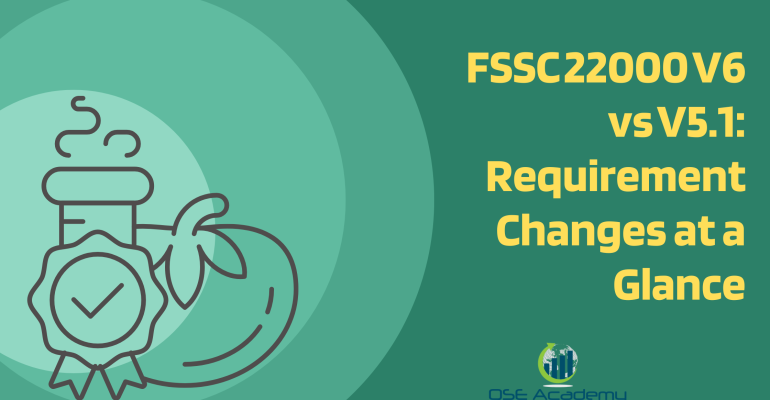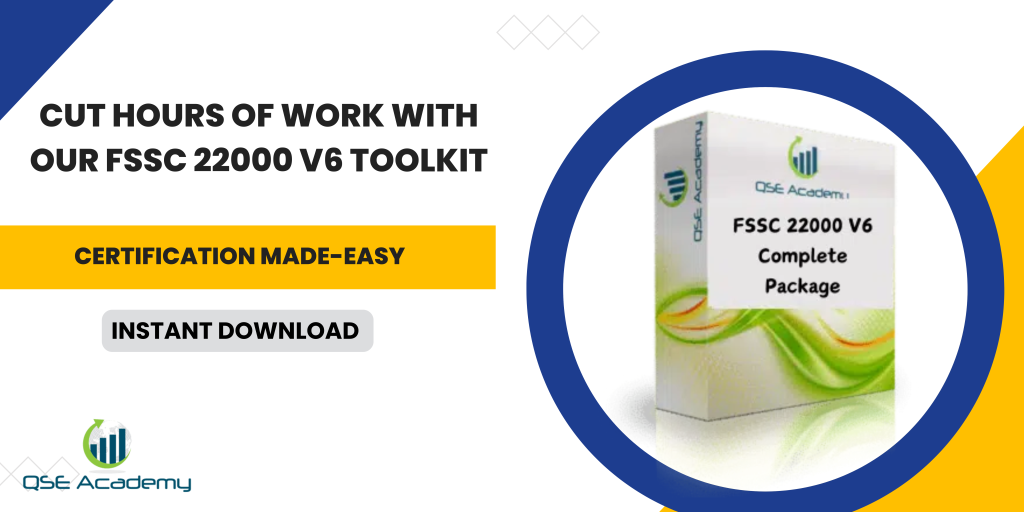FSSC 22000 V6 vs V5.1: Requirement Changes at a Glance
Why This Update Deserves Your Attention
If you’re managing a food safety management system certified under FSSC 22000 V5.1, you’ve probably heard the buzz about Version 6. And for good reason — it’s not just a light refresh.
This article walks you through what changed, why it matters, and how to get your system ready — without feeling overwhelmed.
FSSC 22000 V6 Update Overview: Why the Change Matters
Every revision in the FSSC scheme tells a story. Version 6 wasn’t released just to keep auditors busy — it’s the result of lessons learned from thousands of audits and the evolving expectations of global food chains.
The Foundation FSSC wanted to align more closely with ISO 22003-1: 2022, introduce sustainability awareness, and respond to real audit findings that exposed weak spots in earlier systems.
Here’s what I’ve noticed: organizations that treated this as a “minor version change” often found themselves scrambling during transition audits. The truth is, V6 adds measurable accountability — from management commitment to environmental hygiene metrics.
Pro Tip: Start your transition with a simple gap matrix comparing V5.1 clauses against V6. It’ll save you hours later.
 New Requirements in FSSC 22000 V6: What’s Different and Why
New Requirements in FSSC 22000 V6: What’s Different and Why
The heart of this update lies in its new and strengthened requirements. Let’s break down what changed:
- Food Safety & Quality Culture: V6 goes beyond having a written policy. You now need to demonstrate active engagement — surveys, staff feedback, and improvement plans count.
- Environmental Monitoring Program (EMP): No longer optional. EMP is now a mandatory documented program, especially for ready-to-eat operations.
- Food Fraud & Defense: Strengthened alignment with GFSI. Expect deeper verification of supplier vulnerability assessments.
- Allergen Management: What used to be implied is now explicit. You must document risk analysis and control verification.
- Equipment Maintenance & Calibration: Requirements clarify preventive maintenance expectations — including digital calibration logs if available.
In one of my client projects — a dairy processor — we developed an EMP trend dashboard to visualize microbiological data over time. That simple tool not only satisfied V6 but helped them spot contamination patterns early.
Common mistake: Updating policies without touching procedures. V6 demands evidence of implementation, not just new paperwork.
Revised Additional Requirements: Side-by-Side Comparison
Here’s a quick snapshot comparing key additional requirements between V5.1 and V6:
| Area | V5.1 Requirement | V6 Update |
|---|---|---|
| Food Safety Culture | Policy & plan required | Monitoring & metrics mandatory |
| Quality Control | Optional | Fully integrated into system |
| Allergen Management | Mentioned indirectly | Explicit & documented |
| Environmental Monitoring | Optional | Mandatory EMP program |
| Equipment Management | Not detailed | Clear maintenance & calibration expectations |
These aren’t cosmetic changes — they reshape how you demonstrate compliance.
Pro Tip: Don’t just rewrite your procedures. Link each Additional Requirement to a KPI or monitoring log. It’s the fastest way to show auditors you’re serious about improvement.
Integration with ISO 22003-1: 2022: Audit Process & Duration Changes
One subtle but powerful shift in FSSC 22000 V6 is how it aligns with ISO 22003-1: 2022.
This impacts:
- Audit Duration: Adjusted to reflect risk category and product complexity.
- Sampling Method: Clearer rules on site selection and multi-site coverage.
- Auditor Competence: More defined — auditors must be trained on V6 specifics before conducting transition audits.
This is important because it affects your budget and timeline. Some organizations underestimated the man-days required under V6 and had to reschedule their audits.
Pro Tip: Confirm with your certification body whether your audit duration has changed under the new ISO 22003-1 calculation.
Documentation & Transition Timeline: Stay Ahead of the Clock
The Foundation FSSC announced that all V5.1 certifications expire by March 31, 2025. That gives most organizations less than a year to complete the transition.
Here’s a quick roadmap:
- Perform a Gap Analysis — Identify what clauses and additional requirements you’re missing.
- Update Documentation — Revise PRPs, HACCP plans, and quality manuals to reflect new terms.
- Train Your Team — Awareness sessions for management and staff are essential.
- Conduct an Internal Audit — Include all V6 clauses before the certification body arrives.
One packaging plant I worked with transitioned in just 8 weeks by tackling the EMP and culture requirements first. They didn’t try to fix everything at once — just the high-impact areas.
Common Mistake: Leaving training until the last month. FSSC auditors will expect evidence of competence, not just attendance sheets.
Audit Readiness & Cost Impact under V6
V6 brings more than new requirements — it also shifts how audit readiness and costs are managed.
Expect longer audits for complex sites, especially if you handle allergens, RTE products, or packaging for sensitive goods.
Here’s my advice: integrate V6 clauses into your internal audit schedule right away. Don’t treat it as a separate project — make it part of your ongoing compliance rhythm.
Neglecting supplier updates is another common oversight. If your suppliers haven’t aligned their systems with V6, it could delay your transition approval.
Pro Tip: Update your supplier approval checklist to include V6 Additional Requirements like food fraud mitigation and EMP verification.
Your Action Plan: How to Transition Smoothly
If you want to make your transition stress-free, follow this practical order:
- Gap Assessment: Use the official FSSC 22000 V6 Transition Checklist to benchmark your system.
- Document Revision: Map each new clause to your ISO 22000:2018 documents for easy cross-reference.
- Staff Training: Conduct targeted sessions — one for management (culture, EMP), one for operators (PRPs, allergens).
- Mock Internal Audit: Simulate your Stage 2 Audit at least 60 days before the real one.
When I worked with a frozen-foods producer, this exact approach helped them pass their transition audit without a single major non-conformity.
Pro Tip: QSE Academy’s FSSC 22000 V6 Gap-Analysis Tool automates this mapping — ideal if you’re managing multiple sites.
FAQs
Q1. When does FSSC 22000 V6 become mandatory?
All V5.1 certifications must be upgraded to V6 by March 31, 2025. After that date, audits will only be conducted against V6.
Q2. Do PRPs under ISO/TS 22002 change with V6?
Yes. They’re now more tightly linked to operational controls — especially allergen management, sanitation, and EMP documentation.
Q3. Will auditors need new training for V6?
Absolutely. Certification bodies must ensure all auditors are trained and qualified to assess the new requirements before transition audits begin.
Conclusion: Turning Change into Opportunity
FSSC 22000 V6 isn’t just another compliance hurdle — it’s a chance to strengthen your food safety culture and prove real system maturity.
After guiding more than 50 organizations through transitions, I can confidently say that those who start early and train their teams well find the process surprisingly smooth.
If you’re ready to make the move, download QSE Academy’s FSSC 22000 V6 Gap-Analysis Checklist or book a free consultation to plan your transition strategy.
Melissa Lavaro is a seasoned ISO consultant and an enthusiastic advocate for quality management standards. With a rich experience in conducting audits and providing consultancy services, Melissa specializes in helping organizations implement and adapt to ISO standards. Her passion for quality management is evident in her hands-on approach and deep understanding of the regulatory frameworks. Melissa’s expertise and energetic commitment make her a sought-after consultant, dedicated to elevating organizational compliance and performance through practical, insightful guidance.








